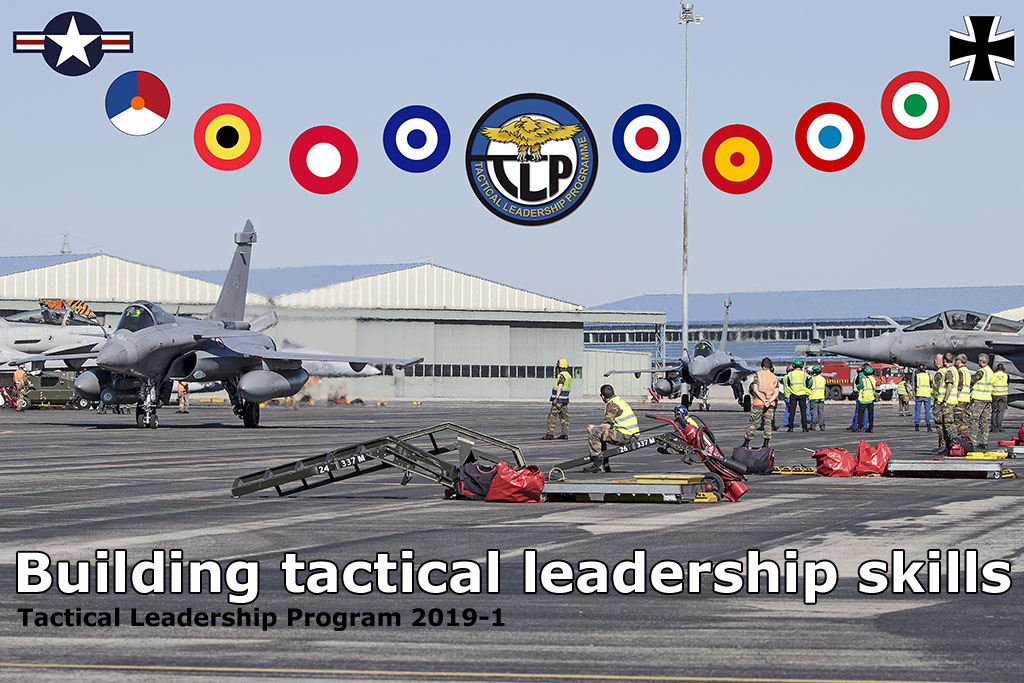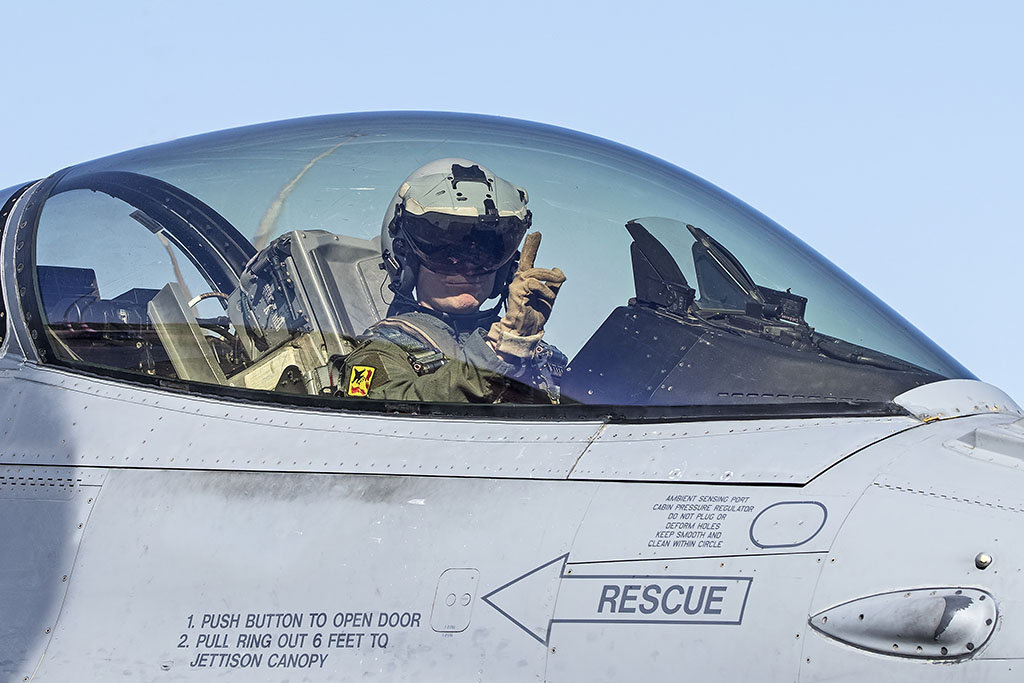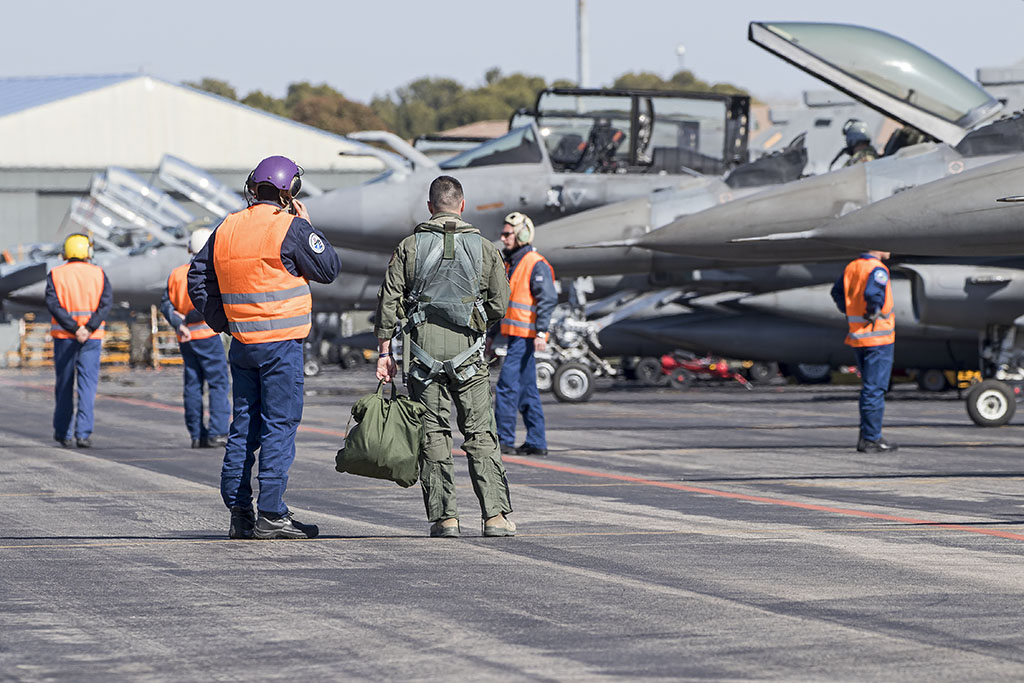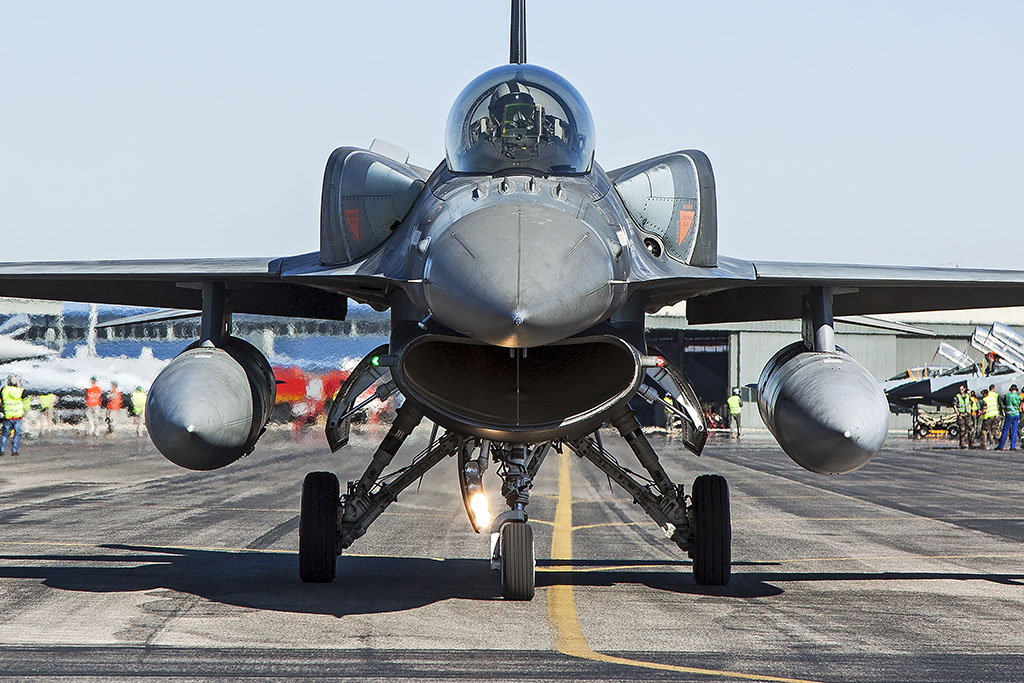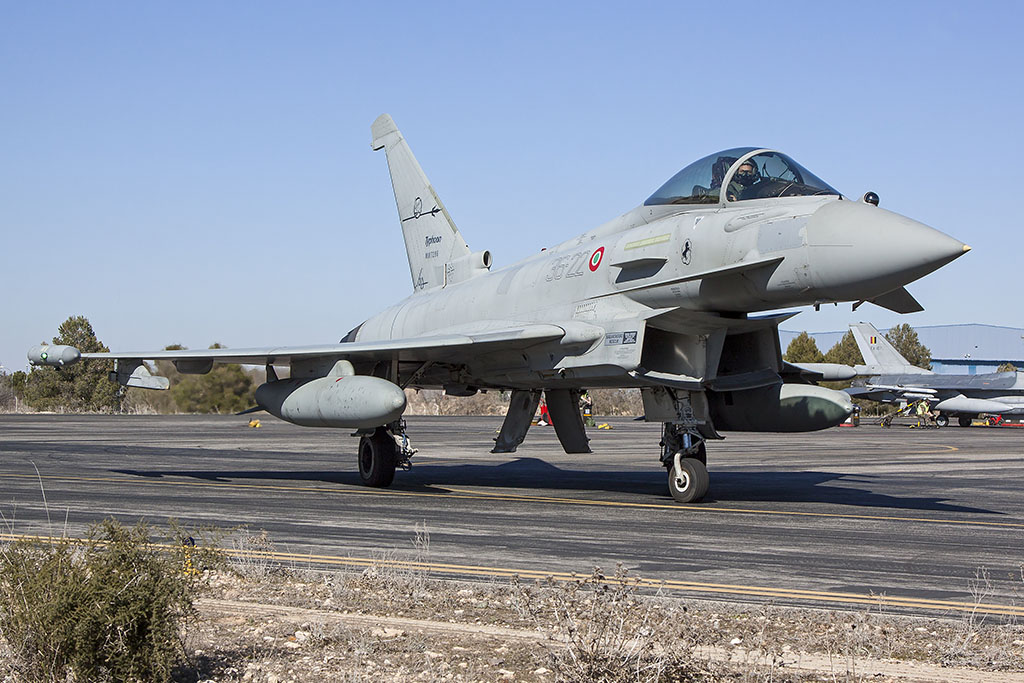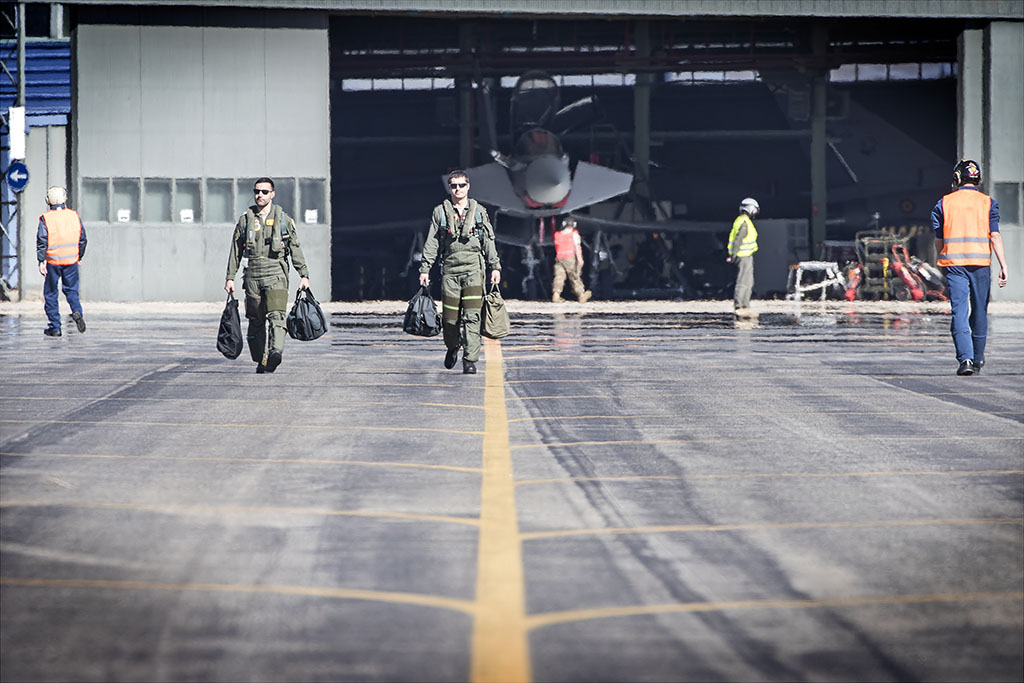During the last 40 years the Tactical Leadership Program (TLP) has become the focal point for NATO's allied air forces tactical training and development of knowledge and leadership skills, necessary to face today's air tactical challenges. The TLP's multinational headquarters is based at Los Llanos Air Base (AB), Albacete, Spain. The TLP's main objective is to increase the effectiveness of NATOs air forces in the field of tactical leadership and conceptual and doctrinal initiatives in support of NATO and of national defence forces. The TLP offers several courses, varying from flying courses aimed at improving flying skills during Composite Air Operations (COMAO), to Combat Search and Rescue (CSAR) and courses aimed at improving intelligence support to COMAO.
Germany
During the cold war, seven NATO nations shared the West German airspace in a defensive cold war posture. Ready to take action at any time. The nations recognized the need for joint operations, the need to train together and the need to generate leaders for challenging multinational air defence and air strike missions. With this aim in mind, in January 1978 the signatory nations Belgium, Canada, Germany, the Netherlands, the United Kingdom (UK) and the United States of America (USA) formed the Allied Air Forces Central Europe (AAFCE) TLP at the German Fürstenfeldbruck Air Force Base (AFB). Early TLP courses took the form of a two-week seminar where aircrew discussed and formulated NATO tactics, techniques and procedures.
In September 1979 the TLP moved to Jever AB in Northern Germany where the course length was extended to four weeks in order to include a flying phase. The TLP took the task to train flight leads to be qualified to plan, brief and conduct multinational combat air patrol missions employing mixed force fighter formations and to lead multinational counter-air-operation-strike-packages. Or in short, to be a successful Mission Commander (MC).
Since the TLP staff was selected from the most experienced and respected airborne leaders in their own air forces, by the end of the cold war the program grew to be the European centre of excellence in all matters related to coalition force air operations.
Belgium
In March 1989, the TLP moved to the Florennes AFB in Belgium, where the staff, the task and the area of responsibility expanded. The TLP added two branches; Concepts & Doctrine Branch and Academic Branch. Aside from flying courses, the program started to instruct allied forces in academic courses and began writing NATO doctrine related to tactical air operations. Starting as a Central Region organization with the mission to defend the inner German border, the TLP adapted new challenges, preparing the future tactical leaders to be ready for conflicts that could take place in any geographic location all around the globe.
The number of nations participating in the TLP Flying and Academic courses and joining the program increased in time (Denmark and Italy joined in 1996, Canada withdrew in 1997, Spain joined in 2002). Aside from the member nations, other countries including some non-NATO allies, began regularly sending military specialists to the TLP to be trained in all the skills related to tactical air operations. For example, the Czech Republic was the first non-member that participated in TLP courses in 2006, Poland followed in 2009.
Spain
As NATO's focus has shifted away from a potential conflict in central Europe, the TLP needed a training area that is representative of the theatres of potential future conflicts. With the dawn of the new century, TLP member nations then started investigating new and more favourable locations for the TLP to cope with the challenge of growing air traffic congestion in Central Europe. The TLPs choice was Los Llanos AB, near Albacete in the South East of Spain. Major Toon 'Kliko', an experienced pilot of the Royal Netherlands Air Force with over 3,000 flying hours on the F-16 alone, says: "The area here is blessed with some of Europe's most favourable meteorological conditions and a large airspace structure. The only disadvantage is that a civil aviation airway runs through the airspace of Los Llanos AB. Every day, our pilots need to consider this in order not to disturb commercial air traffic and – obviously – for air safety reasons. The pilots therefore have to follow the same route as the civil airplanes and that costs about 65% of airtime. Adjusting that civil airway in order to increase the percentage of our airtime requires decisions made by the highest commands. But this takes quite some time, if the route should already be modified at all."
The major is the TLP's Mission Coordinator since 2017, until August 2020. He is responsible for the coordination and planning of all courses given within the TLP. "My tasks are also the compilation of the content of the courses for both aircrew and ground crew and the composition of a varied field of participants and weapon platforms for each course. This requires a lot of consultation and coordination with the member states and with the Host Nation, Spain. I feel a bit like a flying salesman during my TLP-time", says Toon with a smile. Toon will also be active during this year's edition of the Fighter Weapons Instructor Training at Leeuwarden AB, the Netherlands, as Air-Surface Supervisor.
Organizational aspects
In the summer of 2009 the 10 signatory nations signed a new Memorandum of Understanding (MoU). The MoU positioned the TLP outside of, but still linked to, the NATO structure via a Letter of Agreement. The TLP today is organised in a Flying, Academic and Support Branch and lays out as shown in the included organization chart. The major: "As Mission Coordinator I'm part of the Flying Branch. The branch chief is responsible for all flying and directly related operations. The Academic Branch provides non-flying courses, such as the COMAO Planning Course, Support Course, Intell Course and a CSAR Course. The support group takes care of all preconditions, such as lodging, IT, administration, cleaning et cetera." The chiefs of the Flying and Academic Branches are drawn in rotation, whereas the head of the Support Branch is always Spanish.
Kliko continues: "Our mission is to increase the effectiveness of allied air forces through development of leadership skills, mission planning, briefing, tactical air operations and debriefing skills and conceptual and doctrinal initiatives. Therefore, the TLP is committed to the following tasks:
1. Preparation of NATO and allied forces flight leaders to be Mission Commanders who can lead coalition force air strike packages;
2. Instruction of allied flying and non-flying personnel in all matters related to tactical composite air operations;
3. Introduction of new NATO partners and allies to NATO tactical air operations;
4. Provision of tactical air expertise to NATO agencies."
The participating pilots are mostly relatively young, with an experience of about 500 to 1,000 flight hours. In order to train as much crews as possible from as many allied air forces as possible, the TLP flying courses are held on average four times a year, apart from 11 academic courses. Since the relocation of the headquarters in Albacete in 2009, there have been almost 30 flight courses, from which around 750 combat crews have graduated. More than 2,200 students have passed through the academic courses. Many TLP graduates have participated in crisis operations and conflicts in recent years, such as in Libya, Iraq, Syria and Afghanistan.
Course syllabus
A TLP course normally covers three weeks. On the first day, all participants get to know each other and the TLP staff during an introduction session. During this session, the participants provide a capability letter about their platform and the TLP staff assesses the strengths and weaknesses of the group. The first day ends informally.
During the following two so-called academic days, the participating pilots will learn tactical leadership in theory, according to the 4T-principle (Task, Target, Threat and Tactics). "The most important thing we teach our students," says Toon, "is that they have to prevent to 'jump to solutions'. Tactical leadership is all about learning quicker than the enemy, never residing in a situation and acting as one team. This means we require the pilots to have an open mind, so they learn to analyze any given situation and to listen, deliberate, prioritize and advice each other, while conquering language barriers and appreciating each other's input. Solving a problem isn't effective or even possible if the given situation hasn't been analyzed properly and the strengths and weaknesses haven't been deliberated." Then, the participants will each plan and execute three missions within a simulated environment.
After the academic days, the flying days start. Each pilot will plan and fly nine missions, as part of constantly varying threats and tactical training scenarios. The common thread of every scenario is that Red Air (enemy) and Blue Air (NATO) each try to prevent that the other achieves its goals. The most complex scenarios are those during which additional assets, such as airborne warning control systems (E-3A AWACS), radar jamming aircraft, helicopters, transport aircraft and Surface Based Air Defense (SBAD, ground-to-air defense missiles), are part of the scenario. "The most difficult thing for the students is that they have to develop their tactical leadership skills and making their team function as one, simultaneously analyzing a difficult problem and planning a mission to solve it under great time pressure," concludes Toon.
A typical flying day
A typical TLP flying day has a timeline of about 12 hours. The major explains: "The day starts off for our students with analyzing the set targets and possible threats, such as enemy air assets and SBAD, according to the 4T-principle. After the weather briefing and task/scenario briefing, crews withdraw to plan their mission. Our students have to use their lessons learned from previous experiences and the TLP academics to analyze the set targets, terrains, weather conditions, risks and threats and available external support in order to come up with a plan to execute the mission successfully."
Around 14.00h, the first aircrew step to their aircraft and from 15.00h on the TLP platform gets emptier by the minute. "To efficiently launch all participating aircraft in a specific order to meet the requirements of the mission trained is also a part of the TLP", Kliko says. "Within the hour, around 40 aircraft have to be airborne. When the mission is completed, but not later than 18.00h, the aircraft have returned to Los Llanos AB. A flying day concludes with debriefing, during which the staff and students review the executed training mission as well as specific actions and maneuvers executed by pilots. The debriefings result around 22.00h in new lessons learned. These days require very much from our students and I'm proud that we can deliver as many highly trained MC's as we have done already."
The TLP uses a basic scenario, but every course differs in detail and so do the solutions to every assignment given. The assignments presented during the morning briefing are a surprise every day. Even who is in charge as MC. On February 25th, 2019, the main author of this article witnessed the TLP briefings and operations which were aimed at successfully executing a CSAR mission, occasionally called 'operation Odyssey'. The specific mission was to extract a downed USAF F-15E crew from enemy terrains and return safely. One crewmember was supposed to be injured. The crew of a French Air Force EC725R Caracal helicopter had to extract the downed pilots, while being protected by Blue Air from Red Air attacks. Secondary target for Blue Air was to destroy an enemy airfield. Red Air consisted of simulated SBAD, Mi-35 Hind helicopters, MiG 29s and Su-27s. At the end of the day, Blue Air accomplished its objectives and rescued the F-15 crew.
Mission Commander
The final result for TLP's participants is that they become a MC after the three-week course is completed. "A good MC takes command, manages his resources, has the drive to bring home an idea about handling a certain mission and motivates his team", Toon says. "It's all about your credibility as a MC. I think every pilot, especially a MC, has to have the daily drive to become a better pilot. Stagnation means regression. Therefore, it is my drive to make a colleague better than he or she already is and better than I think I am. The TLP is the core to airpower."
The RNLAF makes an exception to the TLP principles. Dutch TLP graduates aren't commissioned a MC-task just because they participated in the TLP-courses. Toon has been a MC twice during his deployments to Iraq and explains why: "The TLP courses are comparable with training and graduating for your driving license. It prepares you well for most situations, but the lessons learned from our experience in the air count the most. To the RNLAF, the TLP is a very good preparation to be a MC. During further training we fine tune our future MCs. During this training period we allow pilots to make mistakes, because those provide the best lessons to learn from. The RNLAF will decide when a pilot is ready to be a MC, a successful completion of the TLP course being a very important requirement besides the MC-exam back in the Netherlands."
During the next TLP-course at Los Llanos AB, 2019-2 starting in May, several Polish pilots will be trained and skilled in tactical leadership, resulting in new MCs.
Overview of participating aircraft in TLP 2019-1
| Belgian Air Component | 6 F-16AM |
| French Air Force | 4 Rafale C, EC725R |
| French Navy | 3 Rafale M |
| German Air Force | 6 Tornado IDS |
| Hellenic Air Force | 3 F-216C, 1 F-1C |
| Italian Air Force | 2 EF2000 |
| NATO | 1 E-3A AWACS |
| Spanish Air Force | 3 EF-18M, 1 Dassault Falcon 20E |
| United States Air Force | 14 F-15E |
This article was also published in Lotnictwo Aviation International 5-2019.
